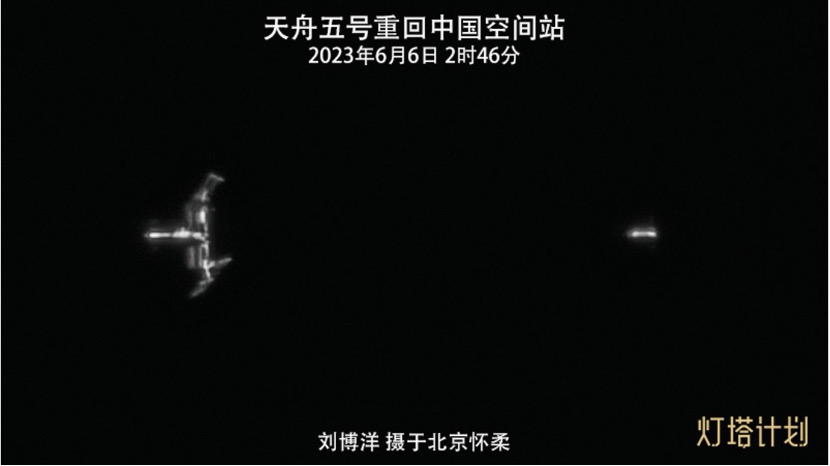
Recently, Liu Boyang, a renowned artificial celestial photographer and the "documenter of China's space station," announced that his team has preliminarily completed an astronomical observatory network consisting of four observation stations. This may also be China's first civilian observation network for artificial celestial bodies.

In April 2023, Liu Boyang's team's work on capturing close-up images and videos of China's space station, titled "Space Station Project 2.0," was selected for the "Lighthouse Project" hosted by Zhihu, the Chinese version of Quora. The "Lighthouse Project" is an honor and incentive program established by Zhihu, which provides maximum cash support of one million RMB for high-quality content creators in the fields of science, humanities, and community spirit.
It is reported that the goal of "Space Station 2.0" is to significantly enhance the team's technological capabilities in space situational awareness within a year, to reach an advanced level in the international field of civilian artificial celestial bodies observation. Liu Boyang's team has adopted an observation network approach and successively established observation stations in Ali,Tibet; Yanqing, Beijing; Lijiang, Yunnan; and Mentougou, Beijing. They have also realized the abilities of analytic imaging of medium and large low-earth orbit spacecraft, and themonitorand orbit determination of medium-to-high earth orbit and cislunar space targets.
Liu Boyang believes that popularizing and interpreting scientific knowledgeintoaccessible language is a way to provide the general public with a platform to appreciate outer space, while independently conducting technological research and using visual images to present the appearance of space are indispensable methods for popularizing astronomy and space science in the "era of space exploration".Liu Boyang, an outstanding and veteran answer contributor in the field of Astronomy on the Q&A platform Zhihu, has received almost 340,000 upvotes for his answers, ideas, and videos for popular science.
In 2022, utilizing a self-developed optical tracking program, Liu Boyang captured close-up images and videos of the Chinese space station, documenting all twelve different configurations during its construction phase. In October 2023, Liu released the space station tracking program free of charge to the entire internet, assisting more astronomy enthusiasts in gazing at the stars. Over the years, Liu has been sharing the process of program development and the shooting on Zhihu and has gained popularity among internet users by providing explanations on the usage of the space station photography software through live streaming.
The "Space Station 2.0" project will continue expanding globally. In the future, additional observatories will also be established in places such as Heilongjiang Province in China and Spain.
Source:Yangcheng Evening News
中国首个民间人造天体观测网初步建成
近日,知名人造天体摄影师、“中国空间站记录者”刘博洋宣布,其团队已初步建成由四个观测站组成的天文台网,这也可能是中国首个民间人造天体观测网。
2023年4月,刘博洋团队关于如何拍摄中国空间站特写影像的《空间站计划2.0》,入选知乎“灯塔计划”。“灯塔计划”是知乎为优质内容创作者设立的荣誉激励金,面向科学、人文、社区精神三大方向,提供单项最高100万元现金资助。
据介绍,“空间站2.0”目标是用一年时间,大幅提升团队在空间态势感知领域的技术储备,力争达到国际民间人造天体观测领域的先进水平。刘博洋团队采用了观测网方案,陆续建成西藏阿里站、北京延庆站、云南丽江站、北京门头沟站,实现对低轨中大型航天器的解析成像能力,和对中高轨、地月空间目标的监测定轨能力。
刘博洋认为,做科普、用通俗的语言“翻译”科学知识,是给普通人搭建领略外太空的台阶;而自主开展技术研发,用影像直观呈现太空面貌,则是“大航天时代”做天文与航天科普不可或缺的方式。刘博洋是知乎天文学话题优秀答主、年度新知答主,在知乎发布的科普回答、想法、视频等内容共获得近34万次赞同。
2022年,刘博洋利用自主开发的光学跟踪程序,拍摄了中国空间站的特写影像,记录下中国空间站建造阶段的全部12种不同构型。2023年10月,刘博洋将空间站跟踪程序面向全网免费发布,帮助更多天文爱好者仰望星空。几年来,刘博洋在知乎记录分享开发程序、追踪拍摄的过程,还通过直播等方式为广大天文与航天爱好者讲解中国空间站拍摄软件的使用方法,受到网友追捧。
文丨记者 杭莹
图丨受访者供图
翻译丨洪婷
-
Foshan's first 'ever bright city' draws crowds during the Chinese New Year holiday
2024-02-22 00:17:03 -
Jieyang: Bustling scenes on the 'colorful bridge'
2024-02-22 00:18:41 -
Pictures|"Fire dragon" parade! Heyuan Draws a Crowd of Thousands
2024-02-22 00:21:43 -
Guangdong-Macao In-Depth Cooperation Zone in Hengqin received 766,000 visitorsduring 2024 Chinese New Year holiday
2024-02-20 22:55:14






